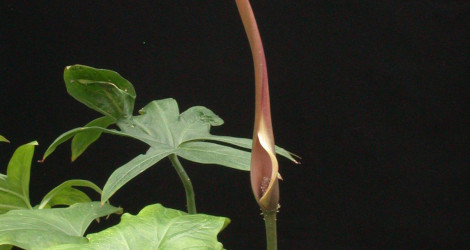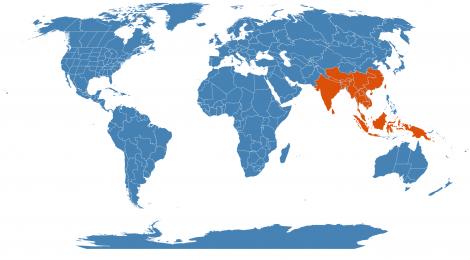Accession Data:
Lasia spinosa (L.) Thwaites
- Common Name:
- Family: Araceae Juss.
- Description: Herbs, 1-2 m tall. Stem long creeping and stoloniferous, erect or ascending, ca. 2.5 cm in diam., internodes with stout prickles. Petiole 32-125 cm, laxly prickly, sometimes almost smooth; pulvinus 15-35 mm, aculeate; leaf blade very variable, sagittate-hastate, 35-65 × 20-60 cm, simple or divided; anterior lobe entire or pedate to near midrib, acuminate; posterior lobes strongly downwardly directed to subspreading, once or twice bifid with 3 or 4 narrow to rather long acute or acuminate lateral segments; primary lateral veins 2-4, strong, secondary lateral veins thinner, higher order veins very numerous, all venation flush above, abaxially with rather small, straight to slightly curved prickles. Peduncle to 47 cm, laxly prickly. Spathe dull orange to black-red outside, dull yellow to rarely dull crimson inside, 18-35 cm with caudate part to 28 cm, proximally widened, very much shorter, 3-10 cm wide. Stipe of spadix obscure; spadix cylindric, 3-5 cm, in fruit elongated to 8 cm. Tepals oblong, 1.5-3 mm, apex triangular hooded, keeled. Filaments ca. 1.5 × 0.8 mm; anthers ca. 0.8 × 0.8 mm. Ovary ovoid, ca. 1.5 mm high. Fruit obpyramidal, ca. 1 cm wide, densely warty-aculeate, sides unarmed, when dry irregularly ribbed, apex truncate. Seed ovoid-cordate, 5-7 mm. Fl. Jul-Sep.5
- Uses: The young leaves are used as a vegetable. The rhizomes are used medicinally for treating tuberculosis of lymph nodes, swollen lymph nodes, stomach aches, snake and insect bites, injuries, and rheumatism.5
- IMPORTANT NOTE: Plant Uses are for informational purposes only. EEB Greenhouses assume no responsibility for adverse effects from the use of any plants referred to on this site. Always seek advice from a professional before using any plant medicinally.
Accession Data:
- Accession # 201900270
- Source: Smithsonian Botany, SI#1999169
- Provenance:
Kress# 99-6487 Kress, W. J.; Bordelon, M.; Williams, K. J.; Thet Htun Myanmar: Mandalay Division: Pyin-Oo-Lwin Township 1 Jul 1999
- Accession Date: 07-10-2019
- Bench: 4108 - EPI: West Wall Rack
- Currently: active - healthy
- Qty: 2 confirmed on 05-15-2024
- Restrictions:
Classification:
- Division: Magnoliophyta
- Class: Liliopsida
- SubClass: monocots
- Order: Alismatales
- SubOrder:
- Family: Araceae
- SubFamily: Lasioideae
- Tribe:
- SubTribe:
Flowering Data:
This accession has been observed in bloom on:| Year | Jan | Feb | Mar | Apr | May | Jun | Jul | Aug | Sep | Oct | Nov | Dec | ||||||||||||||||||||||||||||||||||||||||
|---|---|---|---|---|---|---|---|---|---|---|---|---|---|---|---|---|---|---|---|---|---|---|---|---|---|---|---|---|---|---|---|---|---|---|---|---|---|---|---|---|---|---|---|---|---|---|---|---|---|---|---|---|
| 2025 | ||||||||||||||||||||||||||||||||||||||||||||||||||||
| 2024 | ||||||||||||||||||||||||||||||||||||||||||||||||||||
References (internal):
- EEB Greenhouse Holdings native to: China South-Central / Hainan / China Southeast / Tibet / Taiwan / Assam / Bangladesh / East Himalaya / India / Nepal / Sri Lanka / Cambodia / Laos / Myanmar / Thailand / Vietnam / Borneo / Jawa / Malaya / Maluku / Sulawesi / Sumatera / New Guinea
References (external):
- The Plant List (2013). Version 1.1. Last accessed on Wednesday, 10 July, 2019.
- WCSP (2019). World Checklist of Selected Plant Families. Facilitated by the Royal Botanic Gardens, Kew. Last accessed on Wednesday, 10 July, 2019.
- Image #00 (cropped) & #01 (original) used with the permission of the National Museum of Natural History, Smithsonian Institution, 10th and Constitution Ave. N.W., Washington, DC 20560-0193. Last accessed on Wednesday, 17 July, 2019.
- BGCI Plant Search. Last accessed on Friday, 16 August, 2019.
- Flora of China. Last accessed on Friday, 16 August, 2019.
data regenerated on Wed, 02 Jul 2025 10:00:05 -0400 [bcm v4.0]
Images:

Additional images for this accession:
Click on thumbnails to enlargeCurrent Accessions in the Araceae
Subfamily Aroideae
Subfamily Aroideae
Tribe Anubiadeae
Subfamily Aroideae
Tribe Areae
Subfamily Aroideae
Tribe Arisaemateae
Subfamily Aroideae
Tribe Caladieae
Subfamily Aroideae
Tribe Colocasieae
- Alocasia Amazonica


- Alocasia cuprea

- Alocasia melo

- Alocasia Micholitziana



- Colocasia affinis



- Colocasia esculenta

- Colocasia fallax

- Colocasia gigantea cv. Thailand Giant

- Remusatia vivipara

Subfamily Aroideae
Tribe Culcasieae
Subfamily Aroideae
Tribe Dieffenbachieae
Subfamily Aroideae
Tribe Philodendreae
- Philodendron angustisectum

- Philodendron atabapoense

- Philodendron bipinnatifidum

- Philodendron brandtianum

- Philodendron crassinervium

- Philodendron gloriosum

- Philodendron grazielae

- Philodendron hederaceum var. oxycardium

- Philodendron imbe


- Philodendron joepii
- Philodendron ornatum

- Philodendron panduriforme

- Philodendron patriciae W/C

- Philodendron pedatum

- Philodendron tripartitum


- Philodendron verrucosum

Subfamily Aroideae
Tribe Pisteae
Subfamily Aroideae
Tribe Spathicarpeae
Subfamily Aroideae
Tribe Thomsonieae
- Amorphophallus albus

- Amorphophallus bulbifer


- Amorphophallus dunnii


- Amorphophallus henryi

- Amorphophallus impressus

- Amorphophallus konjac


- Amorphophallus muelleri

- Amorphophallus paeoniifolius

- Amorphophallus pygmaeus W/C


- Amorphophallus titanum


- Amorphophallus titanum


- Amorphophallus titanum


- Amorphophallus titanum


- Amorphophallus variabilis


- Amorphophallus yunnanensis


- Amorphophallus yunnanensis


Subfamily Aroideae
Tribe Zantedeschieae
Subfamily Lasioideae
Subfamily Lemnoideae
Subfamily Monsteroideae
Tribe Monstereae
- Epipremnum falcifolia

- Epipremnum pinnatum
- Monstera adansonii

- Monstera deliciosa



- Monstera dubia

- Monstera siltepecana

- Monstera subpinnata
- Rhaphidophora cryptantha

- Rhaphidophora decursiva
- Rhaphidophora korthalsii

- Rhaphidophora sulcata

- Scindapsus pictus

- Scindapsus pictus 'Exotica'

- Stenospermation sp.
Subfamily Monsteroideae
Tribe Spathiphylleae
Subfamily Pothoideae
Tribe Anthurieae
- Anthurium andraeanum



- Anthurium bakeri



- Anthurium crystallinum

- Anthurium cubense

- Anthurium forgetii

- Anthurium forgetii

- Anthurium forgetii

- Anthurium friedrichsthalii


- Anthurium gracile


- Anthurium luxurians

- Anthurium pedatoradiatum

- Anthurium pendens


- Anthurium pentaphyllum var. bombacifolium

- Anthurium podophyllum W/C



- Anthurium pseudospectabile W/C


- Anthurium scandens


- Anthurium schlechtendalii


- Anthurium veitchii

- Anthurium villenaorum
- Anthurium wendlingeri



Subfamily Pothoideae
Tribe Potheae
Subfamily Zamioculcadoideae
W/C = Wild Collected = indicates flowering in past 14 days
= indicates flowering in past 14 days
 = images available for this accession
= images available for this accession
 = map available for this accession
= map available for this accession
 = accession added within past 90 days
= accession added within past 90 days

